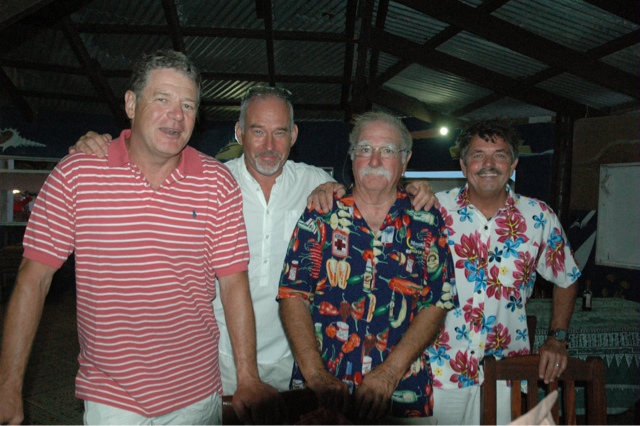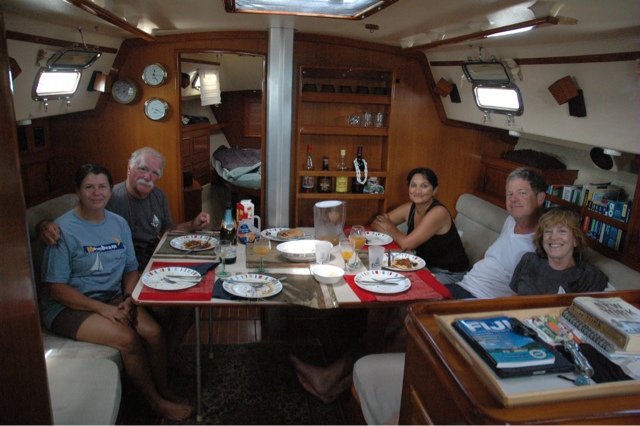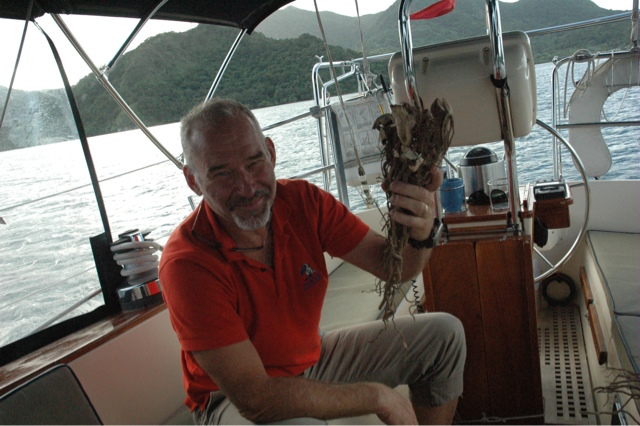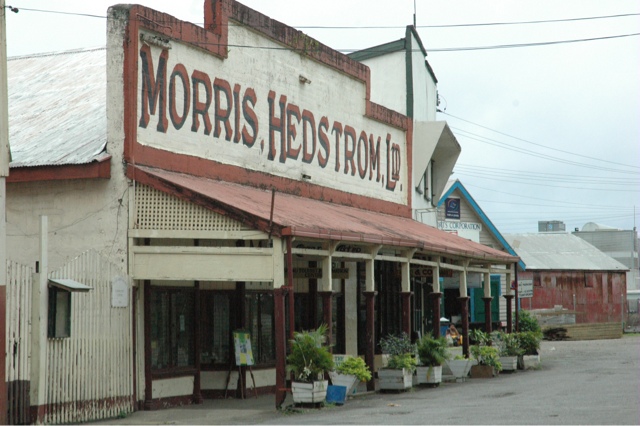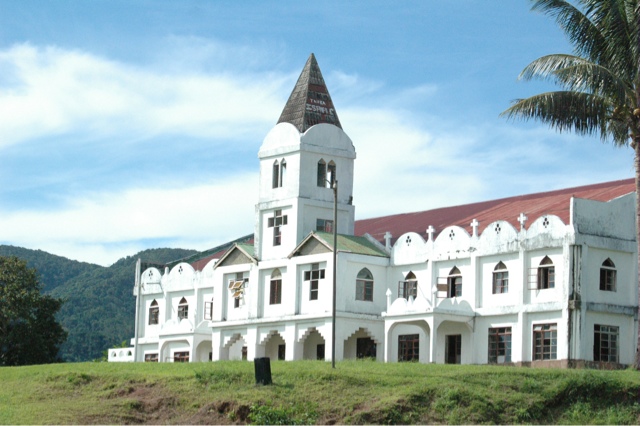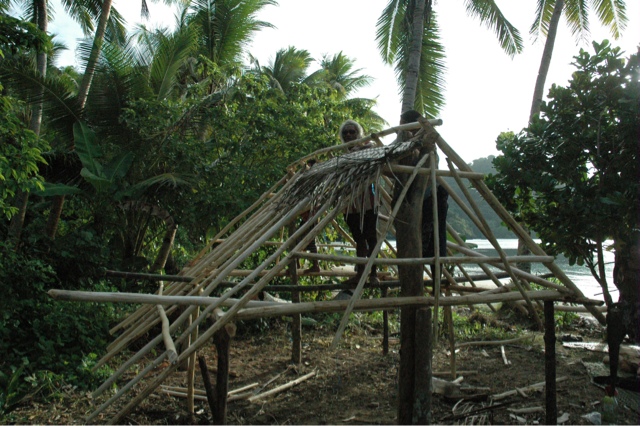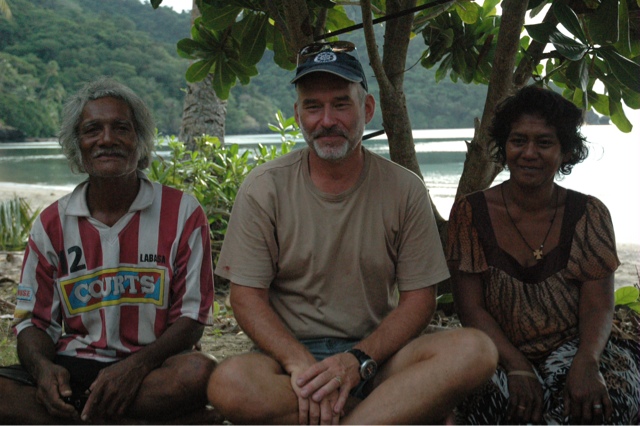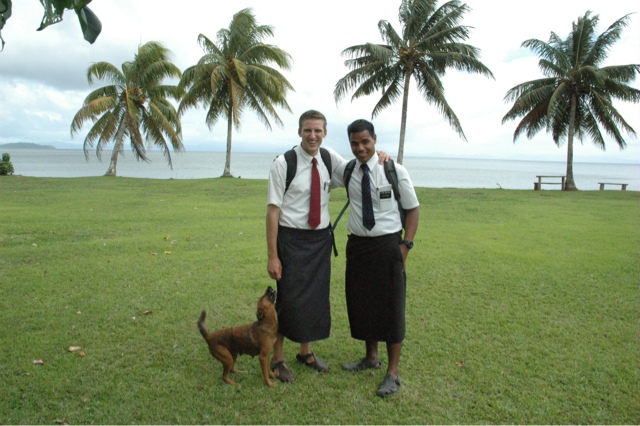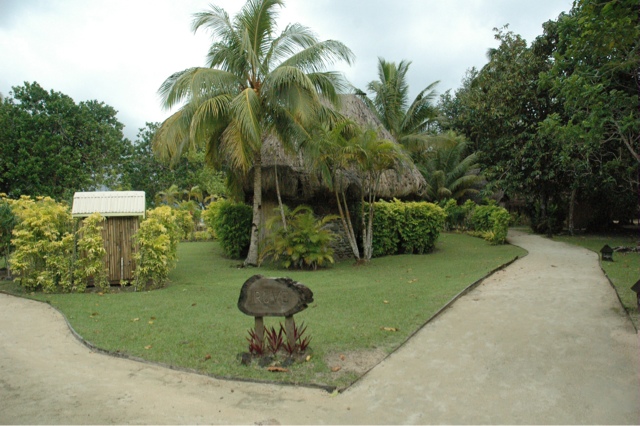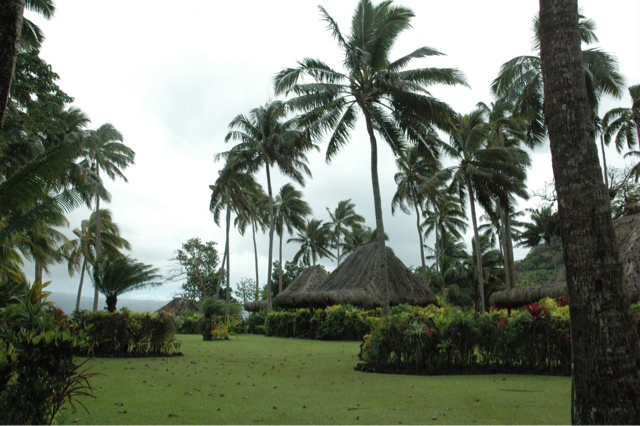Well, the first mate might have spent a few nights at the Westin with the Captain, but I was getting the royal treatment at the Port Denarau Marina. I was gently lifted out of the water and placed 'on the hard' as they say. The treatment started with a power wash and a wet sanding. Ooh boy, did that ever feel delicious. Somewhat like a Turkish bath I would think.
Then it was a couple of fresh coats of antifouling paint, and sanding and painting of my bright work by the Fijian crew while the Captain kept busy with a few small maintenance jobs. I got plenty of attention and I now feel like a million bucks. All dolled up and ready for the next 1400 miles of the journey.
As nice as it was, I ain't no landlubber and am happy to be floating in the warm sea water of the South Pacific once more. The crew has boarded and all feels right with the world.
Thursday, September 26, 2013
Thursday, September 19, 2013
The Manta Ray and Musket Cove
On our way back to Port Denarau we just had to stop in to Musket Cove as we have heard so much about it from other cruisers. It is one of the first marinas to open up in Fiji providing services for the cruisers who had come up from Australia and New Zealand for the season and those of us who have made the puddle jump.
But before that, we spent a night at another island on the Yasawa group and went to find some Manta Rays. Oh, boy. What fun. The pass where they are known to hang out can have quite a lot of current. The reef is also quite lovely with plenty of fish. It was a drift snorkel with the dinghy tied to Jens and just as we are floating by, we see the lovely manta. We had to fin pretty hard to stay with it but it was certainly worth it. We jumped in the dinghy and got ahead of it one more time so we could snorkel with it again. My gosh they are beautiful and strange and incredible creatures. What a treat!
Now, back to Musket Cove. The marina was hit pretty hard by a cyclone last year and they have recovered almost everything it seems. The marina has expanded to become more of a resort with two swimming pools and all the facilities you would expect including a spa and a dive and activity center. The yachties seem to hang out at the Island Bar but we elected to have dinner at Dick's Place.
So now we have checked off two more things on our must do list - Mantas and Musket Cove. Today we go to Denarau for a little TLC for SEGWUN and a nice bed with fluffy pillows for Jens and me!
But before that, we spent a night at another island on the Yasawa group and went to find some Manta Rays. Oh, boy. What fun. The pass where they are known to hang out can have quite a lot of current. The reef is also quite lovely with plenty of fish. It was a drift snorkel with the dinghy tied to Jens and just as we are floating by, we see the lovely manta. We had to fin pretty hard to stay with it but it was certainly worth it. We jumped in the dinghy and got ahead of it one more time so we could snorkel with it again. My gosh they are beautiful and strange and incredible creatures. What a treat!
Now, back to Musket Cove. The marina was hit pretty hard by a cyclone last year and they have recovered almost everything it seems. The marina has expanded to become more of a resort with two swimming pools and all the facilities you would expect including a spa and a dive and activity center. The yachties seem to hang out at the Island Bar but we elected to have dinner at Dick's Place.
So now we have checked off two more things on our must do list - Mantas and Musket Cove. Today we go to Denarau for a little TLC for SEGWUN and a nice bed with fluffy pillows for Jens and me!
The Blue Lagoon
Yes, here we are, at the Blue Lagoon made famous by a prepubescent Brooke Shields in the movie of the same name. Before reaching the calm waters of the Blue Lagoon, we had a windy passage from Port Denarau stopping in to Waya Island and what we had expected to be a calm anchorage for the night. With wind gusts up to 30 knots it turned out to be a really "swell" anchorage. But that didn't stop us from getting in our dinghy to join Ken and his gang for dinner on Moonbeam. We had met Liz, Jack, Mina and Bob at Port Denarau and were looking forward to a fun evening. As Liz described it, we had a delicious dinner of catch the plates and wine glasses! Despite the rolliness, everyone was in fine spirits. Even the sailing novices, Liz and Jack, seemed to be taking it all in stride.
We hauled out of there as early as we could and headed a little farther north making our way through some shallow reefs before turning into the area known as the Blue Lagoon. The wind was still howling, but the water was flat. Ah, peace!
Today we are preparing for a birthday party for Ken. We are baking the cake...no small feat for us since we are slowly depleting our food stocks. But I found a recipe that matched the ingredients I had on board (thank heavens for wifi!!) and I think it will be ok! It has been a combined effort as are most of the meals aboard Segwun. Jens grated the coconut from the ones we received from Rabi Island and he made the template for the decoration as well as helped with the tasting for the chocolate icing.
We had an afternoon dive at 'the maze' before getting ready for the birthday party at Coral View Resort where Jack and Liz were staying. We had a traditional Fijian feast with the food cooked in a lovo which means it is wrapped in leaves and put into an oven in the earth. Then it was a dance performance where the young boys were definitely the stars of the show A little birthday cake and the Moonbeam birthday song, which isn't very long, HA! finished the day. But the celebration continued the next morning with another dive followed by Sunday pancakes on SEGWUN with a little champagne and orange juice to wash it down.
We now need to start making our way back to Port Denarau for a week 'on the hard' as they say. SEGWUN will be hauled out on the 23rd of September. Time for a fresh coat of bottom paint and a little touching up of the bright work. While she's on the hard, we'll be chilling at a local resort which is sure to be a treat. We haven't spent a night on land since February!
We hauled out of there as early as we could and headed a little farther north making our way through some shallow reefs before turning into the area known as the Blue Lagoon. The wind was still howling, but the water was flat. Ah, peace!
Today we are preparing for a birthday party for Ken. We are baking the cake...no small feat for us since we are slowly depleting our food stocks. But I found a recipe that matched the ingredients I had on board (thank heavens for wifi!!) and I think it will be ok! It has been a combined effort as are most of the meals aboard Segwun. Jens grated the coconut from the ones we received from Rabi Island and he made the template for the decoration as well as helped with the tasting for the chocolate icing.
We had an afternoon dive at 'the maze' before getting ready for the birthday party at Coral View Resort where Jack and Liz were staying. We had a traditional Fijian feast with the food cooked in a lovo which means it is wrapped in leaves and put into an oven in the earth. Then it was a dance performance where the young boys were definitely the stars of the show A little birthday cake and the Moonbeam birthday song, which isn't very long, HA! finished the day. But the celebration continued the next morning with another dive followed by Sunday pancakes on SEGWUN with a little champagne and orange juice to wash it down.
We now need to start making our way back to Port Denarau for a week 'on the hard' as they say. SEGWUN will be hauled out on the 23rd of September. Time for a fresh coat of bottom paint and a little touching up of the bright work. While she's on the hard, we'll be chilling at a local resort which is sure to be a treat. We haven't spent a night on land since February!
Wednesday, September 18, 2013
Diving The Great Astrolabe Reef
We have now explored Kadavu and had some really nice dives on the famous reef. We were very much hoping to see mantas, but they remain elusive. At least for us. Maybe next time. Despite that, we had a couple of fabulous days underwater and saw some truly beautiful coral gardens, canyons and walls.
The resorts on Kadavu seem to have very few guests, perhaps because of the remoteness of the island or perhaps because the resorts we visited were a little more rustic in nature. At Dive Kadavu we met Jan, Gord and Michael, a Canadian family that had sailed across from Bora Bora crewing for a Canadian boat Kuan Yin, which is making its way to Australia. They were the only guests at the resort. We had a nice cozy evening with them and came back for lunch after our dive the next day. And at the Waisalima resort we met a young American chap who is in Fiji to study coral. So apart from some nice diving, we met some interesting people.
After a few days, it was time to head to Port Denarau to refill propane and get a few practical things done such as wifi for the blog. And we were looking forward to meeting up with Ken and Lil from Moonbeam once again as they too were headed to Port Denarau for yet another crew change. We also ran into Jan, Gord and Michael on the pier as they were heading out on one of Captain Cooks day charters. We agreed to meet back at the pier later that day and get together for dinner.
So a few dinners and more than a few bottles of wine later, we pulled up anchor and started making our way up to the Yasawas.
The resorts on Kadavu seem to have very few guests, perhaps because of the remoteness of the island or perhaps because the resorts we visited were a little more rustic in nature. At Dive Kadavu we met Jan, Gord and Michael, a Canadian family that had sailed across from Bora Bora crewing for a Canadian boat Kuan Yin, which is making its way to Australia. They were the only guests at the resort. We had a nice cozy evening with them and came back for lunch after our dive the next day. And at the Waisalima resort we met a young American chap who is in Fiji to study coral. So apart from some nice diving, we met some interesting people.
After a few days, it was time to head to Port Denarau to refill propane and get a few practical things done such as wifi for the blog. And we were looking forward to meeting up with Ken and Lil from Moonbeam once again as they too were headed to Port Denarau for yet another crew change. We also ran into Jan, Gord and Michael on the pier as they were heading out on one of Captain Cooks day charters. We agreed to meet back at the pier later that day and get together for dinner.
So a few dinners and more than a few bottles of wine later, we pulled up anchor and started making our way up to the Yasawas.
Local Traditions
After leaving Levuka we arrived to Kadavu (pronounced Kandavu) following the Ferry's route through the reef into the bay. It was pouring rain but we had to go into the village to meet the chief and present our yaqona (pronounced yangona).
Let me explain about the yaqona. Although Fiji was under British Rule from 1874 to 1970, they retained many of their traditions. For example, each village has a chief which is a title descended from a family that has traditionally ruled that area. When you enter a bay it is expected that you should go ashore and visit with the chief to tell him who you are and why you are there. And when meeting the chief you should present him with a gift of yaqona. They call this a Sevusevu.
Yaqona is a pepper plant from which the stalks and roots are dried and pounded into a fine powder and then mixed with water. It looks very much like a dirty gray water. If you drink sufficient amounts of this stuff, you get a numb feeling all over your body and it is supposed to give a calmness but clarity of mind. It starts with a numbing of the lips and tongue and slowly makes its way throughout your body. The drinking of yaqona, or kava as it is known in Tonga, is a very social activity. It is usually consumed during the evenings when the men of the village gather with their guitars and mandolins, sing a few tunes, chat and sip yaqona. The yaqona is served from a large shallow bowl with four legs made out of a single piece of wood. They are often nicely carved and decorated with mother of pearl. A cup made of a half coconut shell is used to scoop out the beverage. It is served by one person who is in charge of the kava bowl, stirring and tasting as necessary. When a cup of yaqona is passed to you, you must first clap (making a hollow clapping sound by rounding out your palms). Then you accept the yaqona using both hands to take the bowl. It must be drunk in one go and the cup returned to the server, after which you then clap three times.
So, back to the Sevusevu. Before meeting the village chief, someone from the village has met you on the beach and asked you several questions about yourself and your journey. This way, he can make a proper introduction of you to the chief. We are ushered into a house and asked to sit on the floor facing the chief. Once we have been introduced we present the yaqona bundle to the chief. He says a few words in Fijian followed by a prayer. The purpose of this ceremony is to get to know you and to welcome you to their village. You are then considered one of them for the duration of your stay and they fully expect you to attend church services if you are still there on Sunday.
To complete they sevusevu they would open the bundle of yaqona roots, pound it into dust and make some kava which you are then obligated to drink with them until the bowl is empty. It seems we always arrive to a village at mid-day or when the chief is away, so we haven't had that experience which is fine because neither Jens nor I really fancy the flavour or the numb feeling it gives. However it is nice to be welcomed to the community and meet the local families and their children who are always there with enthusiastic greetings of BULA!
Let me explain about the yaqona. Although Fiji was under British Rule from 1874 to 1970, they retained many of their traditions. For example, each village has a chief which is a title descended from a family that has traditionally ruled that area. When you enter a bay it is expected that you should go ashore and visit with the chief to tell him who you are and why you are there. And when meeting the chief you should present him with a gift of yaqona. They call this a Sevusevu.
Yaqona is a pepper plant from which the stalks and roots are dried and pounded into a fine powder and then mixed with water. It looks very much like a dirty gray water. If you drink sufficient amounts of this stuff, you get a numb feeling all over your body and it is supposed to give a calmness but clarity of mind. It starts with a numbing of the lips and tongue and slowly makes its way throughout your body. The drinking of yaqona, or kava as it is known in Tonga, is a very social activity. It is usually consumed during the evenings when the men of the village gather with their guitars and mandolins, sing a few tunes, chat and sip yaqona. The yaqona is served from a large shallow bowl with four legs made out of a single piece of wood. They are often nicely carved and decorated with mother of pearl. A cup made of a half coconut shell is used to scoop out the beverage. It is served by one person who is in charge of the kava bowl, stirring and tasting as necessary. When a cup of yaqona is passed to you, you must first clap (making a hollow clapping sound by rounding out your palms). Then you accept the yaqona using both hands to take the bowl. It must be drunk in one go and the cup returned to the server, after which you then clap three times.
So, back to the Sevusevu. Before meeting the village chief, someone from the village has met you on the beach and asked you several questions about yourself and your journey. This way, he can make a proper introduction of you to the chief. We are ushered into a house and asked to sit on the floor facing the chief. Once we have been introduced we present the yaqona bundle to the chief. He says a few words in Fijian followed by a prayer. The purpose of this ceremony is to get to know you and to welcome you to their village. You are then considered one of them for the duration of your stay and they fully expect you to attend church services if you are still there on Sunday.
To complete they sevusevu they would open the bundle of yaqona roots, pound it into dust and make some kava which you are then obligated to drink with them until the bowl is empty. It seems we always arrive to a village at mid-day or when the chief is away, so we haven't had that experience which is fine because neither Jens nor I really fancy the flavour or the numb feeling it gives. However it is nice to be welcomed to the community and meet the local families and their children who are always there with enthusiastic greetings of BULA!
Sunday, September 8, 2013
Port of Levuka
It was a short and smelly stay. We provisioned, slept a little, then left again. The tuna canning factory is right on the wharf as is the diesel power generating plant. So between the two of them the noise and smell overshadow the historic waterfront town of Levuka, a Unesco World Heritage Site.
We had planned to stop for a day or two on our way to the Great Astrolabe reef. Levuka was the first capital city of Fiji. It was built in the early 1800's and has kept the original buildings on the main drag, giving it a rustic, almost western cowboy movie look to it. It has potential, but certainly needs a little jazzing up. Mind you, the biggest downfall is the wharf. The smell of the PAFCO tuna plant and the large fishing vessels (mostly Chinese) didn't encourage us to stay any longer than necessary. So after a short day, it was sayonara Levuka!
We had planned to stop for a day or two on our way to the Great Astrolabe reef. Levuka was the first capital city of Fiji. It was built in the early 1800's and has kept the original buildings on the main drag, giving it a rustic, almost western cowboy movie look to it. It has potential, but certainly needs a little jazzing up. Mind you, the biggest downfall is the wharf. The smell of the PAFCO tuna plant and the large fishing vessels (mostly Chinese) didn't encourage us to stay any longer than necessary. So after a short day, it was sayonara Levuka!
Fiji in the Raw, part ii
And then you have the island of Rabi (pronounced Rambi) which was bought by the British for the Banabans who had to leave their island called Ocean Island because of heavy phosphate mining and war activities in the 1940's. The people on Rabi speak Gilbertese which is not their native language. Herein is another story as told by our new friend Sam (more on Sam a little later). The missionaries came to Ocean Island after having been to Gilbert Island where they learned the language and translated the bible to Gilbertese. So instead of learning the Banaban language, they insisted they learn Gilbertese so they wouldn't have to translate the bible yet again and eventually, over time, the Banaban language was lost.
We spent our first two nights on Rabi at Katharine Bay where you find the village of Buakonikai. The large Methodist Church in the hill is visible far from sea and it is hard to believe that there are enough people on the village to fill the church. I think the Methodists were a little over optimistic when they started the construction.
To visit Rabi on a yacht, you are obligated to 'check in' at the police station in Nuko. Nuko has no good anchorage for yachts so our plan was to take the local bus into town. Well, it isn't actually a bus and it certainly isn't a town. Let me explain. The buses are in total disrepair so for,the past many years it is a truck that makes the daily trip back and forth from Buakonikai to Nuko. It arrives to village at 7AM and we all clamber into the back of a lorry which is equipped with two benches down the side and has a plastic tarp overhead. The lorry stops to pick up and drop off passengers along the way. At one point I counted approximately 60 people aboard which is quite a lot considering you could comfortable sit about 15 people on each bench. It was definitely standing room only at one point. An hour and a half later on a dirt road that climbed up and down several hills, stopping to add water to the overheating radiator every now and again, we arrived to Nuko. It cost us $2.00 per person for the trip back and forth.
Once we arrived, we looked around and quickly saw this 'town' was actually also a very small village. But it too had a large white Methodist Church on the hill and what differentiates it from the other villages is the police station, court house, library and post office. After checking in with the Police, we had about five hours to kill before the truck went back to Buakonikai. We spent some time chatting with a couple of young missionaries from the Church of Latter Day Saints, Erik was from Utah and his companion was from Christmas Island.
The next day we set off for Albert's Cove, said to be one of the most beautiful anchorages in Fiji. We had a wonderful time in the bay which was indeed very pretty with its volcanic rocks and caves at one end, lots of lovely sand beaches and coconut trees and beautiful turquoise water with a good reef for snorkeling. We met Sam when we first arrived and just setting our anchor. He was in his outrigger canoe doing some line fishing and came by to say hello and welcome us to the Cove.
Over the next couple days we got to know Sam and his extended family a little more. It is a two-week school holiday here in Fiji so all the children are home. Normally Sam's family would be at their home in Nuko where the children attend school. Sam refers to himself as 'the old man' in bay and he takes responsibility for that part of Rabi. He was a wonderful host making us feel very welcome. We took a walk to see his yangona (more about this later) plantation and as we walked along the beach we stopped now and then to sample coconuts in their various stages. He sent the two young boys, his son and his grand-nephew, to collect them. They scampered up a tree and knocked down a few green ones. Sam, using his handy machete, trimmed the tops and made a hole so we could have a drink of fresh coconut water. Next we tried the coconut which has just started to sprout. The water in this newly sprouted coconut has turned to a soft sweet sponge and makes a tasty treat. And lastly, we were given some brown coconuts, suitable for grating.
Sam is constructing a new hut in his stretch of the island and the next day Jens gave him a hand with some sawing. It's a simple, but effective construction using materials available to them on the Island with the exception of a few nails. While they were building, Sam's wife was making coconut oil. They husk and grate the coconut and then squeeze the liquid from the gratings. After boiling over an open fire, the water has evaporated and the oil has clarified. Thirty coconuts produces about a gallon of oil.
To earn money, Sam and his family produce copra, collect and smoke sea cucumbers and grow yangona. They basically live off the land and the sea using money to buy rice, flour, sugar and other necessities. A very tragic history these people have of losing their home island and native language, but they are quite content and lead a happy life on their new island.
We watched the dolphins play in the bay for the better part of an afternoon and snorkeled the reef. We left Rabe island early the next morning with our hold full of gifts (a small bottle of coconut oil, six green coconuts, four brown ones, two smoked fish and a lobster) from Sam and his little piece of paradise. With three toots of our horn, we waved goodbye to Sam and set off to see another part of Fiji.
We spent our first two nights on Rabi at Katharine Bay where you find the village of Buakonikai. The large Methodist Church in the hill is visible far from sea and it is hard to believe that there are enough people on the village to fill the church. I think the Methodists were a little over optimistic when they started the construction.
To visit Rabi on a yacht, you are obligated to 'check in' at the police station in Nuko. Nuko has no good anchorage for yachts so our plan was to take the local bus into town. Well, it isn't actually a bus and it certainly isn't a town. Let me explain. The buses are in total disrepair so for,the past many years it is a truck that makes the daily trip back and forth from Buakonikai to Nuko. It arrives to village at 7AM and we all clamber into the back of a lorry which is equipped with two benches down the side and has a plastic tarp overhead. The lorry stops to pick up and drop off passengers along the way. At one point I counted approximately 60 people aboard which is quite a lot considering you could comfortable sit about 15 people on each bench. It was definitely standing room only at one point. An hour and a half later on a dirt road that climbed up and down several hills, stopping to add water to the overheating radiator every now and again, we arrived to Nuko. It cost us $2.00 per person for the trip back and forth.
Once we arrived, we looked around and quickly saw this 'town' was actually also a very small village. But it too had a large white Methodist Church on the hill and what differentiates it from the other villages is the police station, court house, library and post office. After checking in with the Police, we had about five hours to kill before the truck went back to Buakonikai. We spent some time chatting with a couple of young missionaries from the Church of Latter Day Saints, Erik was from Utah and his companion was from Christmas Island.
The next day we set off for Albert's Cove, said to be one of the most beautiful anchorages in Fiji. We had a wonderful time in the bay which was indeed very pretty with its volcanic rocks and caves at one end, lots of lovely sand beaches and coconut trees and beautiful turquoise water with a good reef for snorkeling. We met Sam when we first arrived and just setting our anchor. He was in his outrigger canoe doing some line fishing and came by to say hello and welcome us to the Cove.
Over the next couple days we got to know Sam and his extended family a little more. It is a two-week school holiday here in Fiji so all the children are home. Normally Sam's family would be at their home in Nuko where the children attend school. Sam refers to himself as 'the old man' in bay and he takes responsibility for that part of Rabi. He was a wonderful host making us feel very welcome. We took a walk to see his yangona (more about this later) plantation and as we walked along the beach we stopped now and then to sample coconuts in their various stages. He sent the two young boys, his son and his grand-nephew, to collect them. They scampered up a tree and knocked down a few green ones. Sam, using his handy machete, trimmed the tops and made a hole so we could have a drink of fresh coconut water. Next we tried the coconut which has just started to sprout. The water in this newly sprouted coconut has turned to a soft sweet sponge and makes a tasty treat. And lastly, we were given some brown coconuts, suitable for grating.
Sam is constructing a new hut in his stretch of the island and the next day Jens gave him a hand with some sawing. It's a simple, but effective construction using materials available to them on the Island with the exception of a few nails. While they were building, Sam's wife was making coconut oil. They husk and grate the coconut and then squeeze the liquid from the gratings. After boiling over an open fire, the water has evaporated and the oil has clarified. Thirty coconuts produces about a gallon of oil.
To earn money, Sam and his family produce copra, collect and smoke sea cucumbers and grow yangona. They basically live off the land and the sea using money to buy rice, flour, sugar and other necessities. A very tragic history these people have of losing their home island and native language, but they are quite content and lead a happy life on their new island.
We watched the dolphins play in the bay for the better part of an afternoon and snorkeled the reef. We left Rabe island early the next morning with our hold full of gifts (a small bottle of coconut oil, six green coconuts, four brown ones, two smoked fish and a lobster) from Sam and his little piece of paradise. With three toots of our horn, we waved goodbye to Sam and set off to see another part of Fiji.
Fiji's Slice of Paradise
After 'roughing it' for a week or so, we decided to treat ourselves to a nice cozy dinner at the Qamea Resort and Spa. We are out of wine and gin and are desperately low on beer not to mention our food supplies. We are slowly emptying our freezer in preparation for having the boat hauled out of the water in a couple of weeks. Mind you, we haven't had much opportunity to buy food since we left Savusavu on August 23rd. Anyhow, who needs all these reasons to treat oneself?
We anchored in the bay just around the corner from the resort and dinghyed over to make a reservation. It is only a 15 minute dinghy ride, but the rain was coming down and we arrived there soaking wet. We first stopped in at the dive shop to organize a dive trip for the following morning. Dave, the manager of the dive shop was pretty keen about the dives in their area and we left him looking forward to the next day's excursion.
We wandered along the resort's lovely sand paths and well manicured lawns and gardens, passing the thatched roof bures along the way. The first thing you notice at this resort is the friendly staff. Enthusiastic greetings of BULA met us along the way together with the offer to share an umbrella. The staff here make a point to remember your name so it didn't take long for us to start feeling very much at home, even though we weren't actually guests of the resort.
We dropped into the office and spoke to the resort manager, Belinda who together with her husband Andrew run the place. We asked if we could join for dinner which was absolutely fine with them, even though it is an all inclusive resort and we were standing there looking a little like two drowned rats. Regardless, we were warmly welcomed and Belinda suggested we arrive a little early to enjoy some drinks at the bar which sounded like a darn good idea.
Qamea is a five-star resort with a slew of accolades and awards to its name. It is in a lovely cove with its own beach and a coral garden at it's doorstep. A great destination if you are looking to spend some time in a tropical paradise. We had a delicious three course dinner with an excellent bottle of Stony Corner Cabernet Sauvignon Malbec (now on our list as a favorite). We got to know Belinda and Andrew over cocktails and we finished the evening sitting around the Yangona circle with the musicians. (I realize I still have to explain the Yangona ...).
It was a good thing we stayed a little longer. The rain had started to come down pretty hard and we knew it would be a wet and dark ride back to the boat. By this time, all of the staff at the resort knew we were from the yacht anchored just off the village around in the bay, so they kindly offered to lead us out and around the reef to our boat. It was a pretty hairy ride back and we were thankful they led the way as it wasn't only dark and rainy, it was also a bit misty making it difficult to see.
We arrived safely back to SEGWUN, wet but happy after a lovely evening. And we still had our dive to look forward to the next day. Now, this is paradise!
We anchored in the bay just around the corner from the resort and dinghyed over to make a reservation. It is only a 15 minute dinghy ride, but the rain was coming down and we arrived there soaking wet. We first stopped in at the dive shop to organize a dive trip for the following morning. Dave, the manager of the dive shop was pretty keen about the dives in their area and we left him looking forward to the next day's excursion.
We wandered along the resort's lovely sand paths and well manicured lawns and gardens, passing the thatched roof bures along the way. The first thing you notice at this resort is the friendly staff. Enthusiastic greetings of BULA met us along the way together with the offer to share an umbrella. The staff here make a point to remember your name so it didn't take long for us to start feeling very much at home, even though we weren't actually guests of the resort.
We dropped into the office and spoke to the resort manager, Belinda who together with her husband Andrew run the place. We asked if we could join for dinner which was absolutely fine with them, even though it is an all inclusive resort and we were standing there looking a little like two drowned rats. Regardless, we were warmly welcomed and Belinda suggested we arrive a little early to enjoy some drinks at the bar which sounded like a darn good idea.
Qamea is a five-star resort with a slew of accolades and awards to its name. It is in a lovely cove with its own beach and a coral garden at it's doorstep. A great destination if you are looking to spend some time in a tropical paradise. We had a delicious three course dinner with an excellent bottle of Stony Corner Cabernet Sauvignon Malbec (now on our list as a favorite). We got to know Belinda and Andrew over cocktails and we finished the evening sitting around the Yangona circle with the musicians. (I realize I still have to explain the Yangona ...).
It was a good thing we stayed a little longer. The rain had started to come down pretty hard and we knew it would be a wet and dark ride back to the boat. By this time, all of the staff at the resort knew we were from the yacht anchored just off the village around in the bay, so they kindly offered to lead us out and around the reef to our boat. It was a pretty hairy ride back and we were thankful they led the way as it wasn't only dark and rainy, it was also a bit misty making it difficult to see.
We arrived safely back to SEGWUN, wet but happy after a lovely evening. And we still had our dive to look forward to the next day. Now, this is paradise!
Fiji in the Raw, part i
Before coming to Fiji, we had a certain image in our mind of what it would be like. Probably these images had long been planted there by the pictures in travel brochures or on the television. Images of long stretches of sandy beaches, lovely green islands, thatch roofed huts and spectacular five star resorts interspersed here and there with the requisite number of super yachts anchored in the distance and sailing yachts just off shore with all sails up gliding smoothly across the turquoise ocean. Not unlike Tahiti ... another favorite honeymoon destination.
Contrary to what i first thought, Fiji is made up of two large islands and many, many small islands and archipelagos. You have to zoom in closely to see this on the maps, otherwise you would also believe there is only one island called Fiji. The two large islands are Vanua Levu which is the North Island and Viti Levu which is referred to as the South Island or the main island. Then to the East you have the Northern and Southern Lau groups, an archipelago of roughly 100 small islands. Life on the Lau group of islands remains very traditional and because of their distance from the main islands there are few visitors. Just to the South of Viti Levu you will find the Great Astrolabe Reef. There is said to be some world class diving around this reef; a place we definitely want to explore. And last, but not least are the Mamanuca and Yasawa Groups, home to world renown places such as Musket Cove and a favorite cruising ground for the rich and famous. It is easy to see how you could spend several years exploring the many and diverse islands of Fiji.
We had started our explorations at Savusavu which is on Venua Levu (the North island) and which is where we had to do our clearing in process. Unfortunately this means we passed right by the Lau group but hopefully we'll get to them a little further along on our journey. In the meantime, we learned a little more about Fiji and its population. Currently, about 51% of the people are of Indian decent having arrived here many years ago as labour for the copra plantations. Thankfully they stuck around and have provided us with some truly excellent curry dishes. The traditional Fijian cuisine is similar to Tonga and as I've said, I would be thin as a stick if that is all there was to eat.
For the past week we have been making our way around Vanua Levu. We did a couple of amazing dives in the Somosomo Strait having anchored in the very sheltered and picturesque Viani Bay. From there we moved on to visit the islands off Vanua Levu's Northern shores starting with Kioa Island.
As well as their high Indian population, Fiji has taken in a couple of displaced nations. The people of Kioa had left their island home in the nation of Tuvalu because during WWII they were being ravaged by the war in the Pacific. All the residents of Kioa (around 700 today) are Tuvaluan and have kept their own language, customs and traditions and although they are part of Fiji they have their own government as well. We visited the island, meeting the head of the administration which is a courtesy expected if you are anchoring in their bay. The island has neat and tidy homes, lots of children, its own school and even a network of paved sidewalks. The people here show a great pride in their island and have many small signs to remind their citizens on what is important. Signs such as "a mind is like a parachute, it only works when it is open."
That was our first visit to a small Fijin village that was not so Fijin.
Contrary to what i first thought, Fiji is made up of two large islands and many, many small islands and archipelagos. You have to zoom in closely to see this on the maps, otherwise you would also believe there is only one island called Fiji. The two large islands are Vanua Levu which is the North Island and Viti Levu which is referred to as the South Island or the main island. Then to the East you have the Northern and Southern Lau groups, an archipelago of roughly 100 small islands. Life on the Lau group of islands remains very traditional and because of their distance from the main islands there are few visitors. Just to the South of Viti Levu you will find the Great Astrolabe Reef. There is said to be some world class diving around this reef; a place we definitely want to explore. And last, but not least are the Mamanuca and Yasawa Groups, home to world renown places such as Musket Cove and a favorite cruising ground for the rich and famous. It is easy to see how you could spend several years exploring the many and diverse islands of Fiji.
We had started our explorations at Savusavu which is on Venua Levu (the North island) and which is where we had to do our clearing in process. Unfortunately this means we passed right by the Lau group but hopefully we'll get to them a little further along on our journey. In the meantime, we learned a little more about Fiji and its population. Currently, about 51% of the people are of Indian decent having arrived here many years ago as labour for the copra plantations. Thankfully they stuck around and have provided us with some truly excellent curry dishes. The traditional Fijian cuisine is similar to Tonga and as I've said, I would be thin as a stick if that is all there was to eat.
For the past week we have been making our way around Vanua Levu. We did a couple of amazing dives in the Somosomo Strait having anchored in the very sheltered and picturesque Viani Bay. From there we moved on to visit the islands off Vanua Levu's Northern shores starting with Kioa Island.
As well as their high Indian population, Fiji has taken in a couple of displaced nations. The people of Kioa had left their island home in the nation of Tuvalu because during WWII they were being ravaged by the war in the Pacific. All the residents of Kioa (around 700 today) are Tuvaluan and have kept their own language, customs and traditions and although they are part of Fiji they have their own government as well. We visited the island, meeting the head of the administration which is a courtesy expected if you are anchoring in their bay. The island has neat and tidy homes, lots of children, its own school and even a network of paved sidewalks. The people here show a great pride in their island and have many small signs to remind their citizens on what is important. Signs such as "a mind is like a parachute, it only works when it is open."
That was our first visit to a small Fijin village that was not so Fijin.
Fidget fidget fidget fidget ...Fiji
We arrived to Vanua Levu, the north island of Fiji, checking in at the main town and port, Savusavu. That process went exceptionally smooth and we proceeded to town to get a sim card for our cell phone and hook up some wifi. We have our priorities and one is to get connected to the world as soon as possible after a passage.
it has now been a full week since we have arrived to Fiji. And I am embarrassed to say we have done very little. Well, actually less than that. Ok, maybe not that bad. We actually went for a dive yesterday, which was pretty great. But apart from that, it seems we have slipped into a true cruising mode, even taking on some of the habits of the die aboards, if you can believe it. That means scoping out the restaurants where you can get a main course for around $5.00 per person, happy hour drinks, and so on. We have discovered that Savusavu is a favorite spot for the Kiwi seasonal yachties who come here to escape the cold New Zealand winters (they are the equivalent to the Canadian Snowbirds in Florida). The main attraction is a quiet mooring field, services such as laundry and showers and of course cheap restaurants, groceries and beer.
When we first arrived here, we were approached by a local man asking if he wanted us to polish our boat. After discussing prices, Jens agreed to hire him as we hadn't given the outside a good polish since we left Ecuador in February. He was to polish the stainless steel and all the fiberglass including the hull. A job that would take 2-3 days. It seemed like a good idea at the time.
Well, I didn't know it rained in paradise. Of course you have to expect some rain...a quick afternoon shower now and again, just enough to keep the land lush and green. But four days and nights of rain and drizzle? I had to check if we had somehow arrived in the rainy season, but the brochures confirmed that the rainy season doesn't start till September. Anyway, the rain delayed the polishing work and didn't make it very interesting for us to explore the island. Instead, Jens and I caught up on our reading, found a cheap place to buy DVD movies and had ourselves some very lazy afternoons. We both got plenty fidgety and couldn't wait to get on the move again.
We spent an afternoon with Curly, a local-expat-dieaboard-cruiser who has been sailing the Fijian waters for more than 40 years. He does a seminar for cruisers and gives a lot of very valuable information. We are now armed with waypoints, chartlets and lots of good advice. The low pressure system that caused all the rain has finally moved off and we are off to explore the islands.
Curly also makes homemade lures "guaranteed to catch fish". Jens bought two and was inspired to make a few more of his own. On our first day out he had two lines in the water, one with Curley's lure and one with his. Neither one caught a fish. 'Nuf said.
it has now been a full week since we have arrived to Fiji. And I am embarrassed to say we have done very little. Well, actually less than that. Ok, maybe not that bad. We actually went for a dive yesterday, which was pretty great. But apart from that, it seems we have slipped into a true cruising mode, even taking on some of the habits of the die aboards, if you can believe it. That means scoping out the restaurants where you can get a main course for around $5.00 per person, happy hour drinks, and so on. We have discovered that Savusavu is a favorite spot for the Kiwi seasonal yachties who come here to escape the cold New Zealand winters (they are the equivalent to the Canadian Snowbirds in Florida). The main attraction is a quiet mooring field, services such as laundry and showers and of course cheap restaurants, groceries and beer.
When we first arrived here, we were approached by a local man asking if he wanted us to polish our boat. After discussing prices, Jens agreed to hire him as we hadn't given the outside a good polish since we left Ecuador in February. He was to polish the stainless steel and all the fiberglass including the hull. A job that would take 2-3 days. It seemed like a good idea at the time.
Well, I didn't know it rained in paradise. Of course you have to expect some rain...a quick afternoon shower now and again, just enough to keep the land lush and green. But four days and nights of rain and drizzle? I had to check if we had somehow arrived in the rainy season, but the brochures confirmed that the rainy season doesn't start till September. Anyway, the rain delayed the polishing work and didn't make it very interesting for us to explore the island. Instead, Jens and I caught up on our reading, found a cheap place to buy DVD movies and had ourselves some very lazy afternoons. We both got plenty fidgety and couldn't wait to get on the move again.
We spent an afternoon with Curly, a local-expat-dieaboard-cruiser who has been sailing the Fijian waters for more than 40 years. He does a seminar for cruisers and gives a lot of very valuable information. We are now armed with waypoints, chartlets and lots of good advice. The low pressure system that caused all the rain has finally moved off and we are off to explore the islands.
Curly also makes homemade lures "guaranteed to catch fish". Jens bought two and was inspired to make a few more of his own. On our first day out he had two lines in the water, one with Curley's lure and one with his. Neither one caught a fish. 'Nuf said.
Subscribe to:
Posts (Atom)






